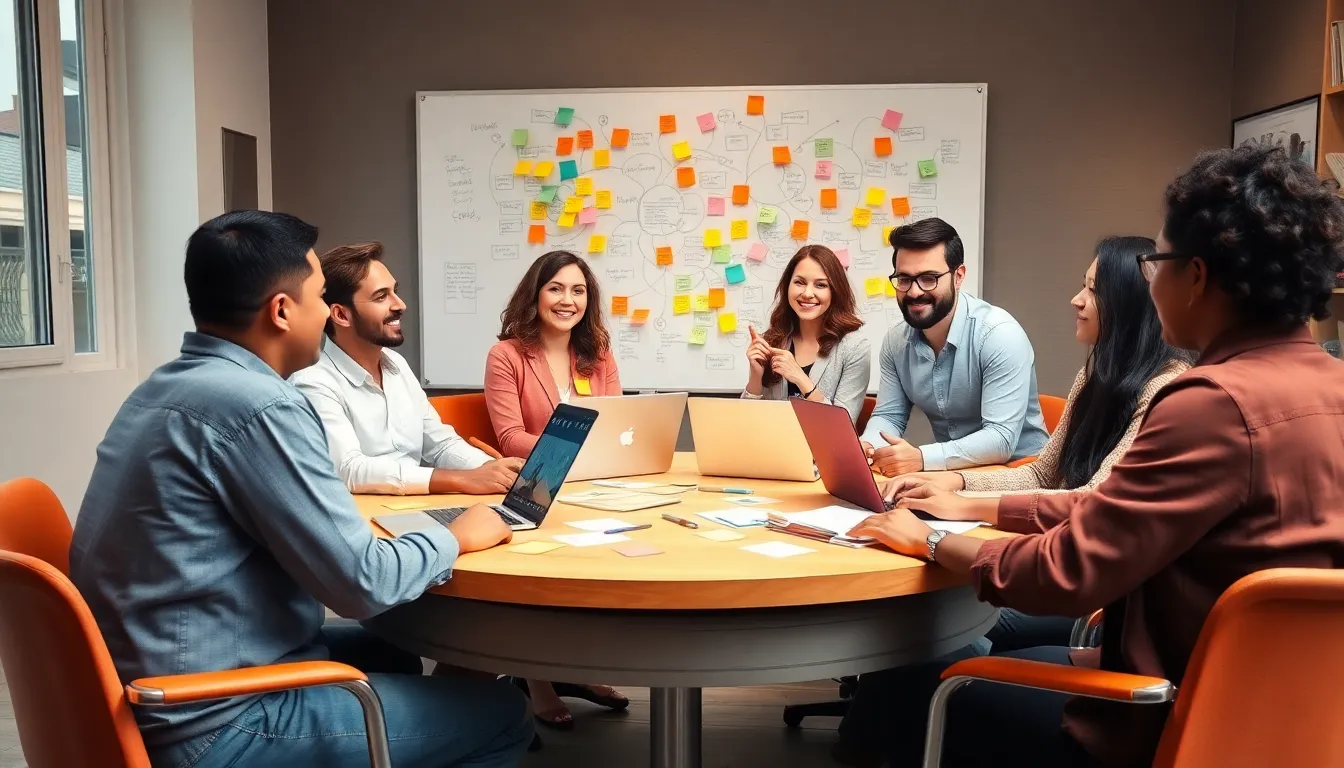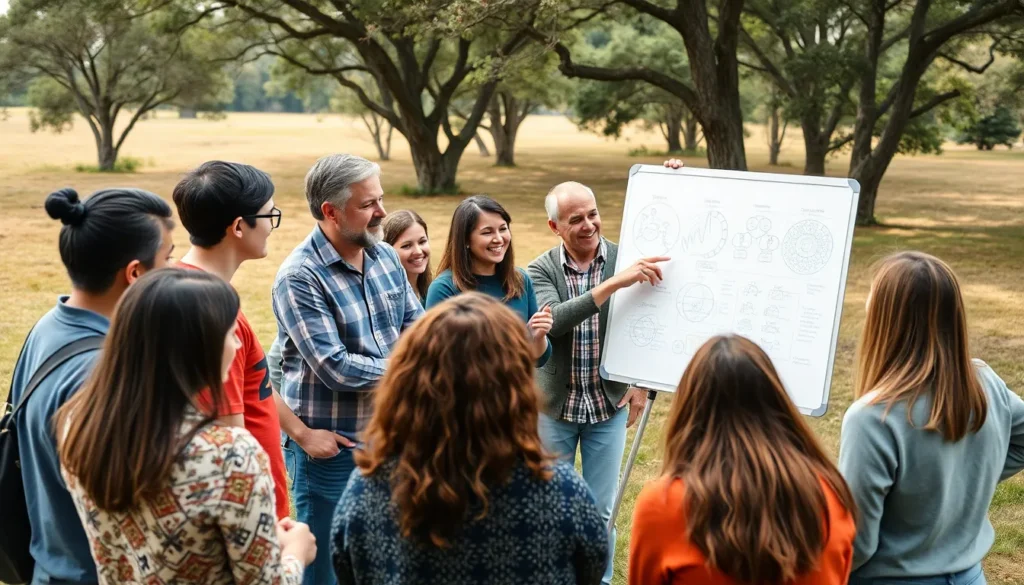Table of Contents
ToggleIn today’s fast-paced world, effective leadership is more crucial than ever. But let’s face it—who said leadership development has to be a snooze-fest? Gone are the days of boring seminars and endless PowerPoint slides. Instead, it’s time to roll up those sleeves and dive into fun, engaging activities that not only sharpen skills but also foster teamwork and camaraderie.
Importance Of Leadership Activities For Adults
Engaging in leadership activities significantly enhances adult development. These activities foster essential skills that contribute to personal and professional growth.
Personal Development
Personal development occurs through participation in leadership activities. Adults gain self-awareness, improving their strengths and identifying areas for improvement. Increased confidence emerges from successfully navigating challenges during activities. Setting and achieving goals within a structured environment encourages personal accountability. Leadership exercises stimulate critical thinking, enabling participants to approach problems creatively. Overall, these experiences cultivate resilience, empowering individuals to face uncertainties and adapt to change.
Team Building
Team building thrives in leadership activities designed for adults. Participants learn to collaborate effectively, understanding the value of diverse perspectives. Open communication skills enhance group dynamics, leading to improved trust among team members. Activities often simulate real-world challenges, requiring teams to strategize and innovate. Strengthened relationships contribute to a supportive work environment. Overall, successful team-building activities reinforce collaboration and promote a unified approach to achieving common goals.
Types Of Leadership Activities

Leadership activities come in various forms, offering options that cater to different preferences and environments. Both indoor and outdoor activities enhance skills while promoting teamwork.
Indoor Activities
Brainstorming sessions encourage creative thinking and problem-solving. Workshops offer hands-on experiences that develop specific leadership skills. Role-playing exercises simulate real-life scenarios, allowing participants to practice decision-making. Group discussions foster open communication and the exchange of ideas. Team-building games strengthen relationships and improve collaboration in a fun setting.
Outdoor Activities
Adventure-based challenges such as obstacle courses build trust and resilience. Scavenger hunts promote teamwork as participants navigate together to achieve objectives. Outdoor retreats create an immersive environment for bonding and reflection. Trust falls help establish connections through vulnerability and reliance on teammates. Team sports encourage strategic thinking and collaboration while keeping participants engaged.
Designing Effective Leadership Activities
Designing effective leadership activities requires a structured approach that addresses both goals and group dynamics. These aspects ensure that activities meet the needs of participants while fostering growth and collaboration.
Setting Goals
Setting clear objectives is crucial for leadership activities. Goals should align with the organization’s mission and values. Participants benefit from specific, measurable outcomes. For example, a team may aim to enhance communication skills or improve decision-making processes. Establishing these goals enables facilitators to design activities that directly address these aims. Furthermore, regularly revisiting and adjusting objectives promotes ongoing engagement and accountability among participants.
Considering Group Dynamics
Considering group dynamics greatly influences the success of leadership activities. Understanding the unique traits of each participant fosters an inclusive environment. Characteristics such as varying communication styles, experience levels, and personalities affect group interactions. Tailoring activities to accommodate these differences enhances participation and collaboration. For instance, mixing individuals with complementary skills can encourage knowledge sharing. Additionally, creating smaller groups allows for more personal connections and engagement, ultimately strengthening team cohesion.
Best Practices For Implementing Leadership Activities
Creating effective leadership activities relies on several best practices. Organizations must structure these activities to maximize engagement and impact.
Creating A Safe Environment
Building a safe environment encourages openness and trust among participants. Facilitators should promote a culture where team members feel comfortable sharing ideas and taking risks. Establishing ground rules at the outset lays a foundation for respectful dialogue. Encouragement leads to more participation from individuals who might otherwise remain silent. Leaders must reinforce positive behaviors by recognizing contributions and honoring diverse perspectives. Openness enhances creativity, allowing participants to explore solutions without fear of judgment. Consequently, a safe environment strengthens relationships and ultimately enhances teamwork.
Encouraging Participation
Encouraging participation boosts the effectiveness of leadership activities. Offering various roles during exercises appeals to different strengths and preferences. Active engagement keeps participants invested in the learning process. Establishing small groups fosters intimacy, making it easier for everyone to share thoughts. Setting clear expectations informs participants about their roles, which helps maintain focus. Additionally, utilizing icebreakers breaks down barriers and warms up the group for deeper conversations. Regular feedback throughout activities ensures that participants feel valued and heard. Such strategies enhance overall engagement, making leadership activities more impactful.
Engaging in leadership activities for adults is crucial for personal and professional growth. These experiences not only enhance essential skills but also foster a sense of community among participants. By embracing both indoor and outdoor activities, individuals can discover new strengths while building trust and collaboration.
The structured approach to designing these activities ensures that they align with organizational goals and cater to diverse group dynamics. Creating a safe and supportive environment encourages open communication, allowing everyone to contribute meaningfully.
Ultimately, investing time in leadership activities leads to a more dynamic workplace where teamwork thrives and individuals feel empowered to lead effectively.




